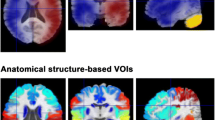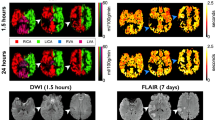Abstract
Delayed cerebral ischaemia (DCI) is the major cause of mortality and morbidity following aneurysmal subarachnoid haemorrhage (SAH). Recent experimental evidence from animal models has highlighted the need for non-invasive and robust measurements of brain tissue perfusion in patients in order to help understand the pathophysiology underlying DCI. Quantitative, serial, whole-brain cerebral perfusion measurements were obtained with pseudo-continuous arterial spin labelling (PCASL) magnetic resonance imaging (MRI) in six SAH patients acutely following endovascular coiling. This technique requires no injected contrast or radioactive isotopes. MRI scanning was well tolerated. Artefact from endovascular coils was minimal. PCASL MRI was able to detect time-dependent and patient-specific changes in voxel-wise and regional cerebral blood flow. These changes reflected changes in clinical condition. Data obtained in healthy controls using the same experimental protocol confirm the reliability and reproducibility of these results. This is the first study to use whole-brain, quantitative PCASL to identify time-dependent changes in cerebral blood flow at the tissue level in the acute period following SAH. This technique has the potential to better understand changes in cerebral pathophysiology as a consequence of aneurysm rupture.





Similar content being viewed by others

References
Vergouwen MD, Vermeulen M, van Gijn J, Rinkel GJ, Wijdicks EF, Muizelaar JP, et al. Definition of delayed cerebral ischemia after aneurysmal subarachnoid hemorrhage as an outcome event in clinical trials and observational studies: proposal of a multidisciplinary research group. Stroke. 2010;41:2391–5.
Dorsch NW. Therapeutic approaches to vasospasm in subarachnoid hemorrhage. Curr Opin Crit Care. 2002;8:128–33.
Weir B, Rothberg C, Grace M, Davis F. Relative prognostic significance of vasospasm following subarachnoid hemorrhage. Can J Neurol Sci. 1975;2:109–14.
Rowland MJ, Hadjipavlou G, Kelly M, Westbrook J, Pattinson KT. Delayed cerebral ischaemia after subarachnoid haemorrhage: looking beyond vasospasm. Br J Anaesth. 2012;109:315–29.
Cahill J, Calvert JW, Zhang JH. Mechanisms of early brain injury after subarachnoid hemorrhage. J Cereb Blood Flow Metab. 2006;26:1341–53.
Aoyama K, Fushimi Y, Okada T, Miyasaki A, Taki H, Shibamoto K, et al. Detection of symptomatic vasospasm after subarachnoid haemorrhage: initial findings from single time-point and serial measurements with arterial spin labelling. Eur J Radiol. 2012;22:2382–91.
Dai W, Garcia D, de Bazelaire C, Alsop DC. Continuous flow-driven inversion for arterial spin labeling using pulsed radio frequency and gradient fields. Magn Reson Med. 2008;60:1488–97.
Wolf RL, Detre JA. Clinical neuroimaging using arterial spin-labeled perfusion magnetic resonance imaging. Neurotherapeutics. 2007;4:346–59.
Wong EC. Vessel-encoded arterial spin-labeling using pseudocontinuous tagging. Magn Reson Med. 2007;58:1086–91.
Okell TW, Chappell MA, Woolrich MW, Gunther M, Feinberg DA, Jezzard P. Vessel-encoded dynamic magnetic resonance angiography using arterial spin labeling. Magn Reson Med. 2010;64:698–706.
Buxton RB, Frank LR, Wong EC, Siewert B, Warach S, Edelman RR. A general kinetic model for quantitative perfusion imaging with arterial spin labeling. Magn Reson Med. 1998;40:383–96.
Chen Y, Wang DJ, Detre JA. Test-retest reliability of arterial spin labeling with common labeling strategies. J Magn Reson Imaging. 2011;33:940–9.
Budohoski KP, Czosnyka M, Smielewski P, Kasprowicz M, Helmy A, Bulters D, et al. Impairment of cerebral autoregulation predicts delayed cerebral ischemia after subarachnoid hemorrhage: a prospective observational study. Stroke. 2012;43:3230–7.
Hattingen E, Blasel S, Dettmann E, Vatter H, Pilatus U, Seifert V, et al. Perfusion-weighted MRI to evaluate cerebral autoregulation in aneurysmal subarachnoid haemorrhage. Neuroradiology. 2008;50:929–38.
Minhas PS, Menon DK, Smielewski P, Czosnyka M, Kirkpatrick PJ, Clark JC, et al. Positron emission tomographic cerebral perfusion disturbances and transcranial Doppler findings among patients with neurological deterioration after subarachnoid hemorrhage. Neurosurgery. 2003;52:1017–22.
Ito H, Kanno I, Kato C, Sasaki T, Ishii K, Ouchi Y, et al. Database of normal human cerebral blood flow, cerebral blood volume, cerebral oxygen extraction fraction and cerebral metabolic rate of oxygen measured by positron emission tomography with 15O-labelled carbon dioxide or water, carbon monoxide and oxygen: a multicentre study in Japan. Eur J Nucl Med Mol Imaging. 2004;31:635–43.
Knutsson L, Stahlberg F, Wirestam R. Absolute quantification of perfusion using dynamic susceptibility contrast MRI: pitfalls and possibilities. MAGMA. 2010;23:1–21.
Wang Z. Improving cerebral blood flow quantification for arterial spin labeled perfusion MRI by removing residual motion artifacts and global signal fluctuations. J Magn Reson Imaging. 2012;30:1409–15.
Aslan S, Xu F, Wang PL, Uh J, Yezhuvath US, Van Osch M, et al. Estimation of labeling efficiency in pseudocontinuous arterial spin labeling. Magn Reson Med. 2010;63:765–71.
Xie J, Gallichan D, Gunn RN, Jezzard P. Optimal design of pulsed arterial spin labeling MRI experiments. Magn Reson Med. 2008;59:826–34.
Acknowledgments
The research was supported by the National Institute for Health Research Oxford Biomedical Research Centre based at Oxford University Hospitals NHS Trust and University of Oxford, the Oxfordshire Health Services Research Committee, the UK Medical Research Council and the National Institute of Academic Anaesthesia.
Compliance with Ethics Requirements
All procedures followed were in accordance with the ethical standards of the responsible committee on human experimentation (institutional and national) and with the Helsinki Declaration of 1975, as revised in 2008 (5). Informed consent was obtained from all patients for being included in the study. Ethical approval for the study was obtained from the Oxfordshire NHS Research Ethics Committee B (09/H0605/128).
Conflict of Interest
Michael Kelly, Matthew Rowland, Thomas Okell, Michael Chappell, Rufus Corkill, Jon Westbrook, Peter Jezzard and Kyle Pattinson declare that they have no conflict of interest. Travel expenses of Richard Kerr were paid by Target Therapeutics to attend the 2003 Association of American Neurosurgeons Annual Scientific Meeting to deliver a lecture regarding the International Subarachnoid Aneurysm Trial.
Author information
Authors and Affiliations
Corresponding author
Additional information
Michael E. Kelly and Matthew J. Rowland are joint first authors.
Electronic supplementary material
Below is the link to the electronic supplementary material.
ESM 1
(DOC 188 KB)
Rights and permissions
About this article
Cite this article
Kelly, M.E., Rowland, M.J., Okell, T.W. et al. Pseudo-Continuous Arterial Spin Labelling MRI for Non-Invasive, Whole-Brain, Serial Quantification of Cerebral Blood Flow Following Aneurysmal Subarachnoid Haemorrhage. Transl. Stroke Res. 4, 710–718 (2013). https://doi.org/10.1007/s12975-013-0269-y
Received:
Revised:
Accepted:
Published:
Issue Date:
DOI: https://doi.org/10.1007/s12975-013-0269-y



